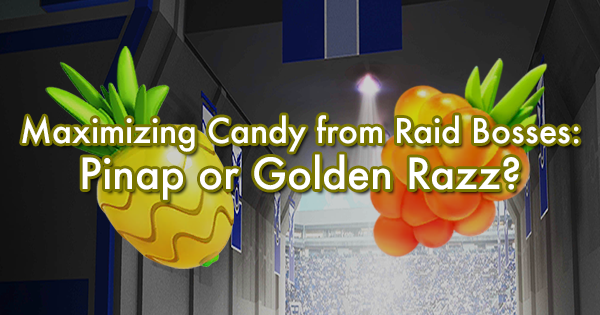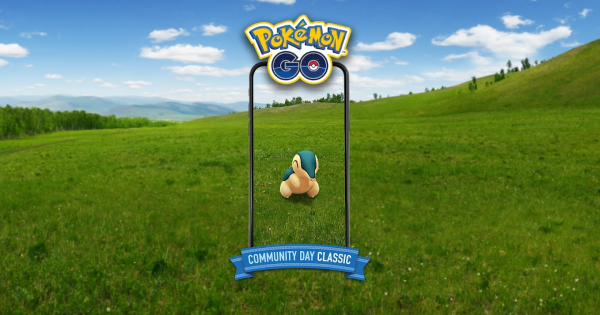Introduction
This guide provides a simple formula to determine the optimal strategy that maximizes the expected candies gained from catching a raid boss.
Conclusion
-
The optimal strategy is always using Pinap Berry first and Golden Razz Berry (GRB) last.
-
The number of balls left where you switch to GRB is independent of the number of balls you receive
Let
-
$p_{1}$ be the catch rate of using GRB
-
$c_{1}$ be the number of candies gained of using GRB
-
$p_{2}$ be the catch rate of using Pinap
-
$c_{2}$ be the number of candies gained of using Pinap
Where $0 < p_{2} < p_{1} < 1$ and $0 < c_{1} < c_{2}$. Then:
-
If $p_{1} c_{1} > p_{2} c_{2} $, then the optimal strategy is using GRB in the last $k$ balls, where $$ k = \lceil \log_{1 - p_{1}} ( \frac{ c_{2} - c_{1} }{ c_{1} } \frac{ p_{2} }{ p_{1} - p_{2} } ) \rceil $$
-
If $p_{1} c_{1} \leq p_{2} c_{2} $, then it is optimal to always use Pinap.
For the bosses with base catch rate of 2% (including the current Eon Duo), assuming you have golden badges, and you’ll transfer the boss if caught (and get one candy, during non-candy-event), the optimal strategy is:
| Excellent Curve | Great Curve | Nice Curve | |
|---|---|---|---|
| Non-boosted |
    |
     |
       |
| Weather Boosted |
     |
      |
        |
The result above uses the Grand Unified Catch Theory. From it, we calculate the catch rates on a single throw in all cases:
| Excellent Curve | Great Curve | Nice Curve | |
|---|---|---|---|
| Non-boosted | 14.668% / 6.154% | 12.166% / 5.054% | 9.837% / 4.054% |
| Weather Boosted | 13.207% / 5.514% | 11.167% / 4.626% | 8.832% / 3.628% |
Derivation
In any case (using GRB or Pinap), denote the catch rate as $p$ and the number of candies gained as $c$.
Let $X_{n}$ be the number of candies gained with $n$ balls to throw. $X_{n}$ takes two possible values:
\[ X_{n} = \begin{cases} c & \quad \text{with the probability of } p \\ X_{n-1} & \quad \text{with the probability of } 1-p \end{cases} \]Therefore:
$$E[X_{n}] = pc + (1-p)E[X_{n-1}] $$At the $n$-th last ball, use GRB if and only if
$$ p_{1}c_{1} + (1-p_{1})E[X_{n-1}] > p_{2}c_{2} + (1-p_{2})E[X_{n-1}] $$That is (with the assumption that $p_{1} > p_{2}$):
$$ E[X_{n-1}] < \frac { p_{1}c_{1} - p_{2}c_{2} } { p_{1} - p_{2} } $$If $p_{1} c_{1} \leq p_{2} c_{2} $, then it is never optimal to use GRB (hence use Pinap only) since
$$E[X_{n}] \geq 0 \geq \frac { p_{1}c_{1} - p_{2}c_{2} } { p_{1} - p_{2} }$$If $p_{1} c_{1} > p_{2} c_{2} $, then the proof continues.
Note that $E[X_{n}]$ increases in $n$. Hence, if it is better to use GRB at the $n$-th last ball, then it must be also better to use GRB at the $(n-1)$-th last, at the $(n-2)$-th last, ..., and at the last ball, since:
$$ 0 = E[X_{0}] < E[X_{1}] < \dots < E[X_{n-1}] < \frac { p_{1}c_{1} - p_{2}c_{2} } { p_{1} - p_{2} } $$Likewise, if it is better to use Pinap at the $(n+1)$-th last ball, then it must be also better to use Pinap at the at the $(n+2)$-th last, ..., and at the first ball:
$$ \frac { p_{1}c_{1} - p_{2}c_{2} } { p_{1} - p_{2} } \leq E[X_{n}] < E[X_{n+1}] < \dots $$Suppose using GRB in the last $k$ balls is the optimal strategy. That is, it is better to use GRB at the $k$-th last ball and to use Pinap at the $(k+1)$-th last ball. Thus:
$$ E[X_{k-1}] < \frac { p_{1}c_{1} - p_{2}c_{2} } { p_{1} - p_{2} } \leq E[X_{k}] $$Since it is always using GRB from the $k$-th last ball to the very last ball, we have:
\[ \begin{cases} E[X_{k-1}] = (1 - (1-p_{1}) ^ {k-1} ) c_{1} \\ E[X_{k}] = (1 - (1-p_{1}) ^ {k} ) c_{1} \end{cases} \]Plug in and solve the inequality with respect to $k$, and it will give:
$$ k = \lceil \log_{1 - p_{1}} ( \frac{ c_{2} - c_{1} }{ c_{1} } \frac{ p_{2} }{ p_{1} - p_{2} } ) \rceil $$--
Results have been independently confirmed by reddit user u/ZicNik in this thread.










